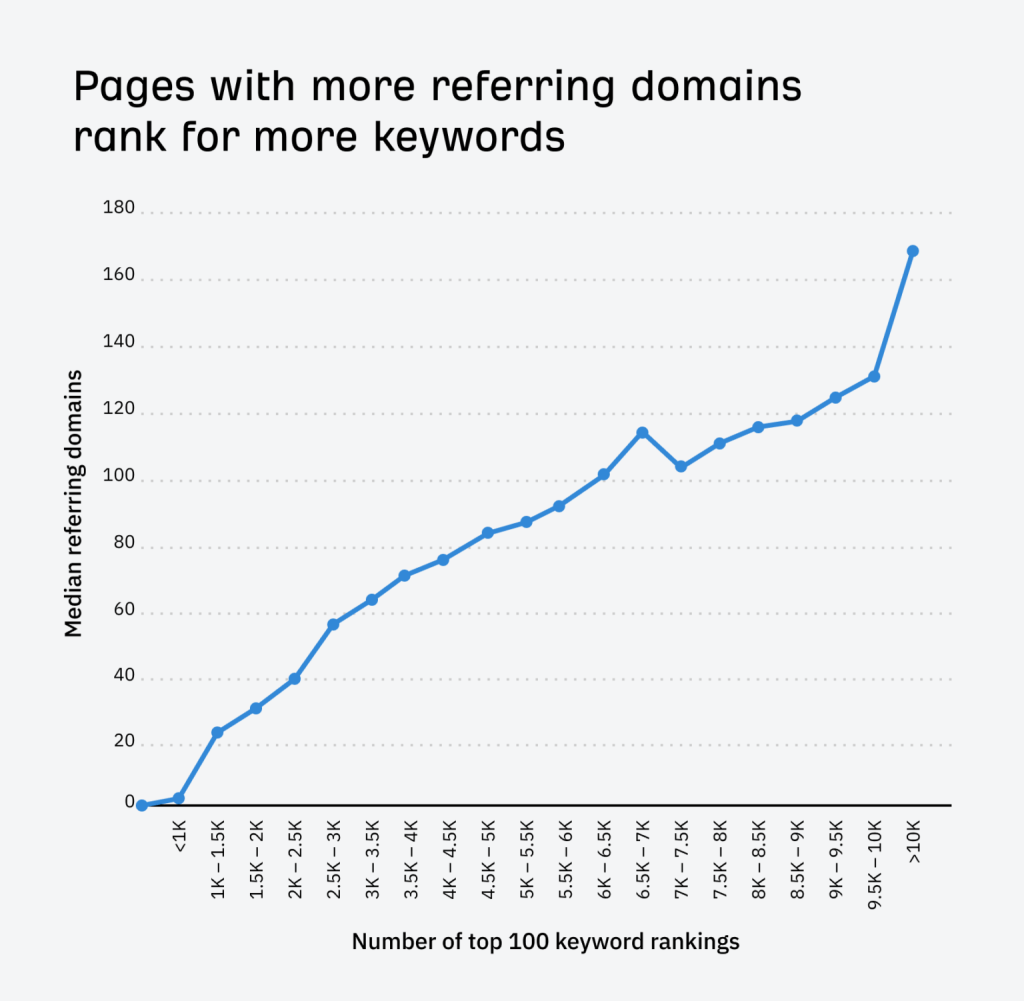What is a Website Link?
A website link (a hyperlink) is a clickable word, phrase, or image that leads a website user from one web area to another. It can be from one place on a web page to another or a completely different URL.
Components of a Website Link
With a website link, you have three components:
- URL (Uniform Resource Locator): A website address to which the link points to.
- Anchor Text (or Image): A clickable piece of text (a hyperlink) or a clickable image, button, etc.
- HTML Code: The underlying code that creates the hyperlink and helps send the user to the new URL location.
Type of Website Links
In total, there are three types of website links. These are:
- Internal Links
- External Links
- Inbound Link (Backlinks)
Each of them plays an important role in website performance. Some more than others. However, overall, they all work together to improve SEO results.
Internal Links
Internal links are hyperlinks that help link pages on the same website together. For example, you may link one blog post to another.
There are several types of internal links. These include navigational, footer, contextual, and sidebar links.
- Navigational Links: Usually found on site-wide menus.
- Footer Links: These are found at the bottom of a website.
- Contextual Links: These are long-form pieces of content like blog posts.
- Sidebar Links: Usually found on the sidebar of a website.
Internal links guide users and bots through your website. This improves user experience and crawlability. It also passes “Link Juice” from one page to another, increasing page and search rankings.
External Links
External links (otherwise known as outbound links) are links from one website to another. For example, you may link to a case study from a blog post on your website.
When it comes to external links, you have a few different types: nofollow and dofollow links.
- Nofollow Links: Tell search engines not to pass ranking signals to the externally linked page.
- Dofollow Links: Tell search engines to pass ranking signals to the externally linked page.
External links improve the credibility and value of content. This helps with Google’s E-E-A-T guidelines.
However, too many links, which is why you can create nofollow links, can decrease SEO performance.
The goal of external links, the same as the other types of links, is user experience. If it benefits the user, it’s a good external link. If it doesn’t, then it shouldn’t be used.
Inbound Links (Backlinks)
Backlinks (otherwise known as inbound links) are from other websites to your own. These are also called “a vote of confidence”.
You can get a few types of backlinks. These include follow, rel=”nofollow”, rel=”sponsored”, and rel-”UGC”:
- Follow: Pass on link juice to the linked source.
- rel=“nofollow”: Don’t pass on link juice to the linked source.
- rel=“sponsored”: Label links as sponsored content and don’t pass on link juice.
- rel=“ugc”: Label links as UGC, and don’t pass on link juice.
Follow backlinks are arguably the most important ranking factor in SEO. The other backlinks do pass on signals but not link juice, which is the most important. What they do is help build website authority.
You can see how important backlinks are in SEO from the research from Ahrefs below:

As you can see, pages with more referring domains (backlinks) rank for more keywords and thus get more traffic.
The “Full Circle” of Website Linking
When it comes to website linking, the best way to think about it is through this “Full Circle” analogy.
- Backlinks build domain authority.
- Internal links pass the page authority (and users) through your website.
- External links increase the value of your content and also pass page authority to another website.
Therefore, it all works together. Backlink builds authority. Internal links pass it through your website. You then pass this authority back to another website via an external link.
Backlinks without internal linking only pass link juice to one page, not the entire website. Internal links without backlinks don’t pass on page authority. External links with no backlinks or internal links don’t benefit the linked source.
Benefits of Website Linking
Website linking, regardless of type, can provide a lot of benefits regarding website performance. These include but are not linked to:
PageRank & Link Equity
Though patented in 1998, PageRank still plays an important role in how search engines work.
PageRank, simply put, is a value assigned to a web page that’s used to determine the order in which search engine results are presented.
Nobody fully knows how PageRank works, but backlinks are important for boosting PageRank on website pages.
The more backlinks you get from high-quality and relevant sources (this is very important), the higher PageRank is assigned to a page. Of course, other factors like user experience, search intent, and page speed also play a role in this.
But how do you get more of that link equity around your website? Through internal linking. Each page you internally link to that has a backlink pointing towards it gets a bit of that PageRank.
Please note: Backlinks are links pointing to your website from other websites, and external links are links pointing from your website to other websites.
That’s why website owners created “Linkable Assets”. It’s a story for another day, but these help build PageRank easily, which can then be internally linked to other pages.
Credibility & Trustworthiness
All types of links, internal, external, and backlinks, build credibility and trust. This is mainly through the E-E-A-T guidelines set by Google.
Internal links help by improving the user experience (linking to other helpful assets on your own website) and by passing authority through your website. Both in which help fulfil E-E-A-T. Think of them as building credibility and trust within your site.
External links, on the other hand, build credibility and trust through association. When you link to relevant, high-quality, and credible external sites, it boosts the value of your content. Alongside this, it also helps build relationships for future backlink opportunities.
Backlinks, alongside the above, boost credibility and trust through endorsement. Search engines look at backlinks as a “vote of confidence” or “third-party validation”, indicating that your content is trustworthy and credible.
Domain Authority
Lastly is domain authority, which is the overall “strength” of your website compared to others within the same niche.
Internal links, external links, and backlinks all improve domain authority. Backlinks are certainly the best. However, internal links also play a role in distributing authority across the website.
External links, though, don’t have a huge impact on domain authority. However, they do help fulfil E-E-A-T guidelines, which indirectly improves rankability and, therefore, domain authority.
Best Practices for Website Linking
Quality over Quantity
It doesn’t matter what type of link you use; always focus on quality over quantity.
Over the years, there have been many black hat SEO techniques that followed the quantity method. And they worked for a little while.
However, search engines are way too smart now. Focus on white hat SEO techniques and build quality internal, external, and backlinks.
As the graph below shows, you don’t need loads of backlinks to rank in the top 10 SERPs.

Laser-Focused Relatability
This goes back to quality. Don’t only link to high domain authority websites. This isn’t necessarily quality.
Quality links are links that have high domain authority (relative to industry) and are related to your target audience or niche.
For example, for this SEO blog, this is how you’d look at quality relatable linking opportunities:
- Non-industry – not quality
- Industry – good quality
- Industry + location – super high quality
Typically speaking, the harder the link is to find or obtain, the better results it’ll have on your website.
Strategic Placement
Don’t randomly place links; be strategic about it. All links should be natural, as this is best for the user’s experience.
Internal links should help users explore related content, external links should be used to support claims or provide additional resources, and backlinks should point to relatable pages (maybe even high-converting pages, depending on the page).
Natural Anchor Text
The anchor text, which is the hyperlinked text of the link, should be natural. It should clearly state what the user will find if they click on it. For instance, if you hyperlink a blog post called “Basics of SEO”, they expect to learn more about SEO basics.
Balanced Link Profiles
Don’t use the same anchor text for internal links or backlinks. This can appear spammy and can negatively impact your website’s performance.
For example, don’t use the anchor text “Basics of SEO” for your blog post about SEO basics over and over again. Instead, use “Basics of SEO”, “SEO for beginners”, “Understanding SEO”, etc.
This appears more natural and balanced, which is something search engines prefer. Some people, in extreme circumstances, audit link profiles to ensure maximum effectiveness.
Avoid Link Overload
Going back to quality – less is always more. Never overload links – internal, external, or backlinks. It doesn’t look natural to search engines and could lower website performance.
Final Word
That’s a full introduction to website linking. Put simply, internal links pass authority, backlinks build authority, and external links build credibility.
All, in which, directly impact SEO in one way or another. However, use them sparingly. Don’t overload on low-quality links. Only use high-quality and relevant links for the best performance.


